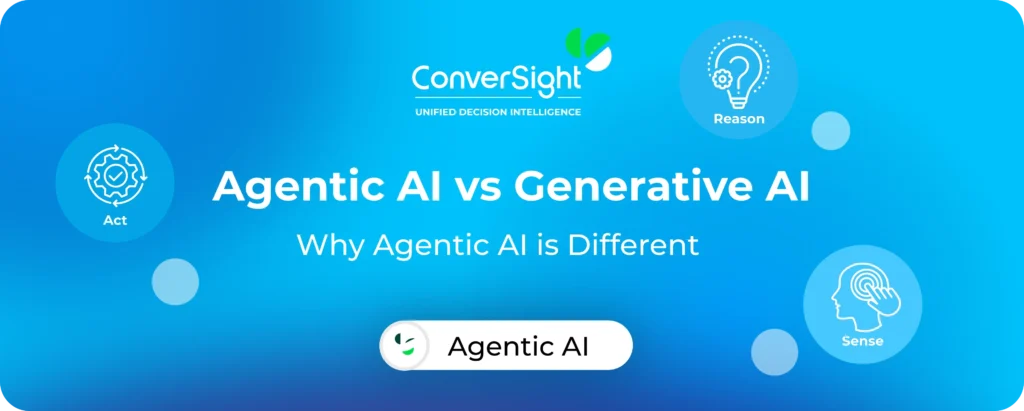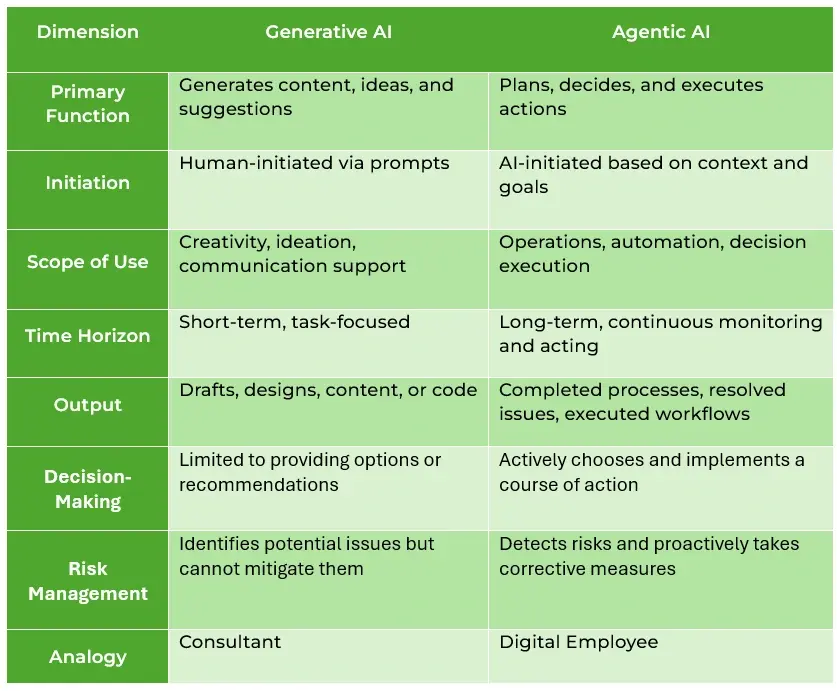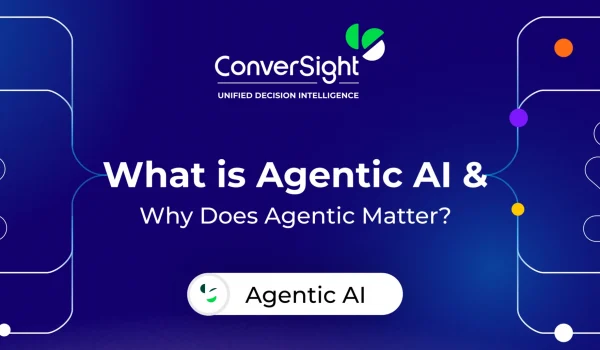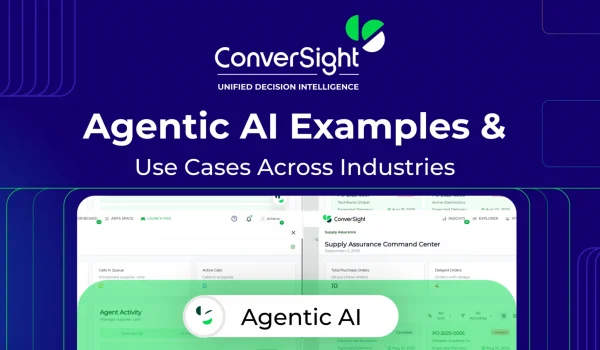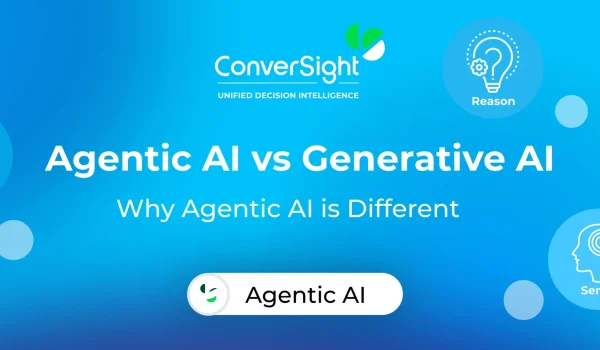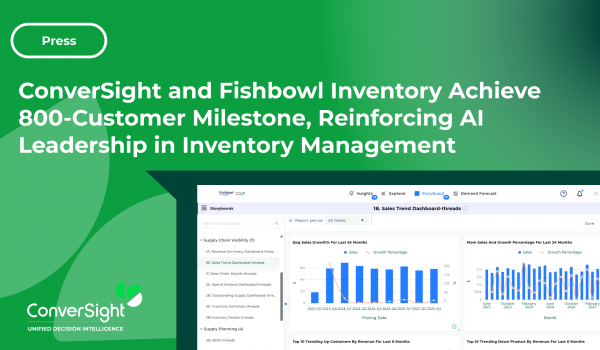Why Agentic AI vs Generative AI matters now — key differences, business impact, and how ConverSight’s Agentic AI helps you choose the right solution.
Agentic AI vs Generative AI: The Beginning
Artificial Intelligence has rapidly evolved from a research domain into a driving force for digital transformation across industries. Within just a few years, terms like “Generative AI” and “Agentic AI” have become essential to understanding how businesses can leverage AI for competitive advantage. But while these concepts are often used interchangeably, they represent very different capabilities—and the difference is critical for supply chain leaders who want to ensure their organizations stay competitive.
Why Agentic vs Generative Matters Now
Generative AI, popularized by tools like ChatGPT, DALL·E, and Copilot, demonstrated the creative potential of machine learning at scale. It captivated business leaders with its ability to write, design, code, and converse. Yet, as organizations look for tangible ROI from AI adoption, it is becoming clear that creativity alone is not enough. Businesses need AI that not only generates ideas but also acts on them—bridging the gap between insights and execution.
This is where Agentic AI comes in. Unlike Generative AI, which responds reactively to prompts, Agentic AI acts autonomously within defined goals and boundaries. It doesn’t just suggest; it executes. Understanding this distinction is essential as enterprises consider how AI can move from boosting productivity to fundamentally reshaping operations.
Learn How ConverSight is Leading the Agentic AI Revolution → Click here!
What is Generative AI?
Generative AI refers to systems that produce original outputs—text, images, audio, or code—based on training data and human prompts. It has revolutionized content creation and automation across industries.
Strengths
- Creativity at Scale: Generates endless variations of text, art, and ideas.
- Natural Language Fluency: Understands and responds to human input in intuitive ways.
- Productivity Boost: Speeds up repetitive or ideation-heavy tasks.
Limitations
- Reactive by Nature: Always requires a human to initiate interaction with prompts.
- No True Autonomy: It doesn’t “decide” to act unless instructed.
- Context Gaps: Often lacks situational awareness beyond the given input.
What is Agentic AI?
Agentic AI represents a more advanced paradigm. Instead of only generating responses, it integrates sensing, reasoning, and acting into one cohesive loop.
Agentic AI systems function within a “Sense → Reason → Act” cycle. They analyze input data from multiple sources, evaluate potential decisions against business goals or constraints, and take autonomous action—all without waiting for human intervention. g safe, interpretable AI in high-stakes operations, such as finance, healthcare, or regulatory environments.
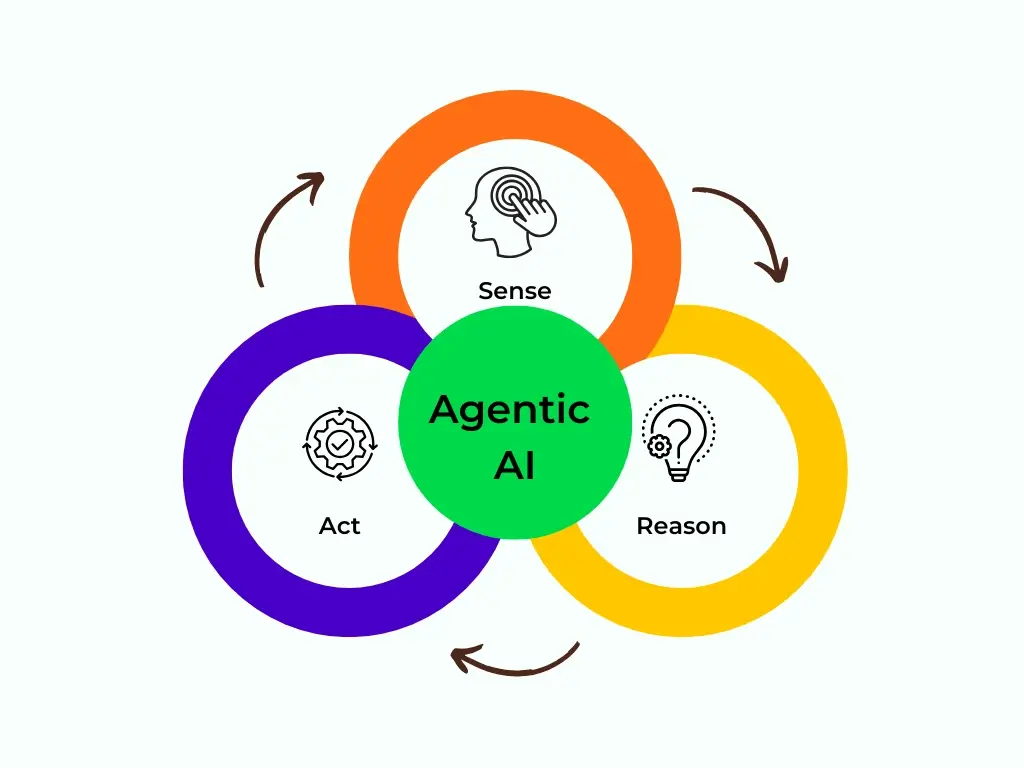
How Agentic AI Differs from Generative AI
Generative AI creates. Agentic AI executes. Where Generative AI stops at producing ideas, Agentic AI follows through with autonomous decision-making and task execution. It doesn’t just generate a list of supplier options—it evaluates them, negotiates, and finalizes agreements.
For enterprises, this shift is monumental. Agentic AI is not simply a digital assistant—it acts like a digital colleague. It proactively monitors environments, manages processes, and addresses problems before they escalate. This goes beyond saving time; it fundamentally changes how work gets done.
Examples
- Supply Chain: Detects shipment delays, identifies alternative suppliers, negotiates terms, and updates procurement systems.
- Finance: Tracks cash flow anomalies, initiates reconciliations, and ensures compliance with regulations.
- Customer Service: Handles routine queries, escalates exceptions, and follows through until resolution.
- Healthcare: Schedules follow-up appointments, adjusts care pathways based on patient data, and triggers alerts for clinicians.
Agentic AI vs Generative AI: Key Differences
While both are transformative, their roles, strengths, and limitations are distinct. Framing them together reveals why enterprises need to adopt them in tandem.
Comparison Across Dimensions
Business Impact of Agentic AI vs Generative AI
The distinction between creativity and execution defines their impact on businesses. Both technologies are powerful, but they shape value creation in different ways.
Generative AI: Creativity and Productivity
It serves as a catalyst for idea generation and efficiency, amplifying human creativity and accelerating repetitive work:
- Marketing Campaigns: It speeds up the creative cycle by producing multiple variations of copy, visuals, and campaign ideas, enabling faster testing and time-to-market.
- Customer Engagement: AI-powered chatbots deliver natural, human-like responses that enhance customer support and improve satisfaction across digital touchpoints.
- Software Development: AI-assisted coding tools generate boilerplate code, debug issues, and suggest optimizations, reducing developer workload.
- Design and Content Creation: Teams use it to create graphics, prototypes, and written content at scale, empowering non-specialists to contribute.
- Knowledge Summarization: Large volumes of documents or reports can be distilled into concise insights for decision-making.
Generative AI is a force multiplier for productivity, helping teams work faster and more creatively. Yet, it still requires human steering, validation, and execution. Its role is to expand possibilities—not to carry them out.
Agentic AI: Efficiency and Execution
Agentic AI elevates business impact by moving from ideation to autonomous action. It doesn’t just recommend what could be done—it executes what should be done in alignment with business goals:
- Supply Chain: Detects potential delays, proactively initiates supplier negotiations, reroutes shipments, and updates forecasts to minimize disruption.
- Finance: Automates reconciliation, flags anomalies in real time, ensures proactive compliance, and initiates corrective actions before risks escalate.
- Customer Service: Monitors queries across channels, prioritizes urgent issues, resolves routine requests automatically, and escalates complex cases with full context to human agents.
- Procurement: Manages the end-to-end process from vendor communications to negotiations, purchase orders, and fulfillment tracking.
- Human Resources: Automates onboarding, monitors employee compliance training, and addresses routine HR queries, freeing teams for culture and talent strategy.
- Healthcare: Tracks patient vitals, adjusts care plans dynamically, and initiates clinician alerts without waiting for manual intervention.
Agentic AI drives not only productivity but also autonomous strategic execution, reducing human effort in operational workflows and freeing talent to focus on higher-order decision-making, innovation, and long-term strategy.
ConverSight’s Agentic AI
onverSight is pioneering the practical use of Agentic AI through its Unified Decision Intelligence platform, making it possible for enterprises to embed autonomous agents directly into day-to-day operations without disruption or heavy IT overhead.
Real-World Workflows Powered by ConverSight
- Supplier Negotiations: Rather than waiting for procurement officers to manually intervene, ConverSight’s Agentic AI continuously monitors supply chain health, flags risks in real time, and autonomously initiates renegotiations with vendors—helping businesses secure continuity, and resilience.
- Demand Forecasting: By continuously analyzing ERP data and historical trends, ConverSight provides early alerts on demand shifts and proactively recommends production adjustments—helping businesses minimize disruptions, reduce waste, and protect margins.
- Procurement Automation: Routine tasks such as generating purchase orders, validating vendor performance, and managing fulfillment are handled end-to-end by ConverSight’s AI agents. This not only speeds up cycle times but also eliminates manual bottlenecks and human error.
- Decision Support for Executives: Beyond execution, the platform delivers AI-driven recommendations, risk assessments, and scenario analyses—providing leaders with ready-to-act insights instead of static reports.
Explore how agentic AI can transform your business—start your journey with ConverSight today. Book a Demo!
Use case: Supply Assurance App
Supplier management often requires procurement teams to react to delays, disruptions, or quality issues after they’ve already impacted operations. This manual, reactive approach slows response times and exposes businesses to unnecessary risk.
ConverSight’s Agentic AI changes this dynamic by making supplier negotiations proactive, autonomous, and continuous:
- Real-Time Risk Monitoring: The platform continuously monitors supply chain health—tracking supplier performance, delivery schedules, and logistics data. When risks such as delayed shipments, missed commitments, or service-level gaps are detected, the AI flags them immediately.
- AI-Initiated Negotiations: The system autonomously initiates renegotiations with vendors—whether adjusting delivery timelines, requesting alternatives, or renegotiating terms—always within pre-set business guardrails.
- Business Continuity and Resilience: By resolving issues before they escalate, ConverSight helps ensure uninterrupted supply and operational continuity, strengthening resilience in complex supply chain environments.
- Human-in-the-Loop Oversight: Procurement leaders retain full visibility into the negotiation process.
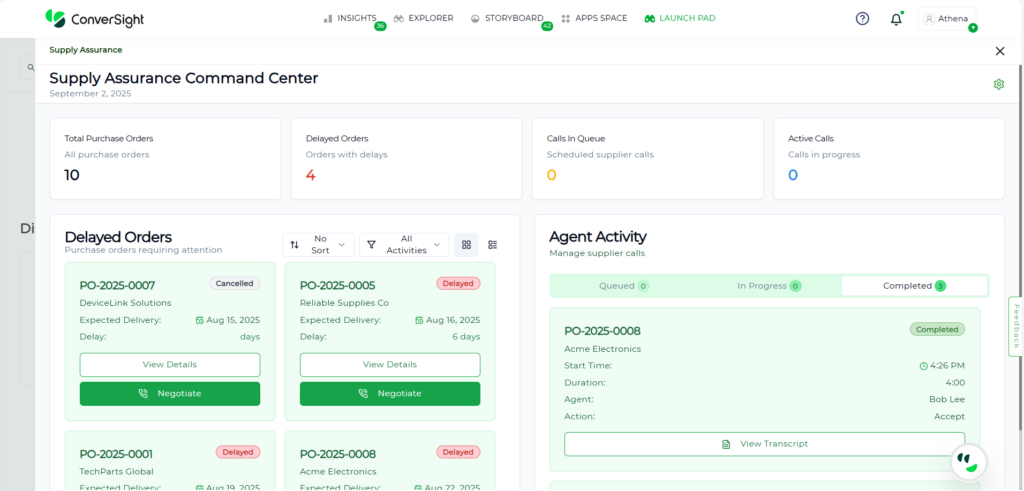
Gen AI to Agentic AI: Challenges & Considerations
The shift from Generative AI to Agentic AI introduces new opportunities but also new responsibilities.
- Trust and Transparency: Businesses must ensure that Agentic AI decisions are explainable and aligned with corporate values.
- Governance: Clear rules and oversight are necessary to define the boundaries of autonomous action.
- Balance: Generative AI’s creativity complements Agentic AI’s autonomy. Over-reliance on either risks imbalance: too much creativity without execution leads to inertia, while unchecked autonomy risks misaligned decisions.
Choosing the Right AI for Your Business
The conversation around AI is not about choosing between Generative and Agentic models—it’s about understanding how they complement each other. Generative AI fuels creativity and ideation, while Agentic AI drives execution and operational resilience.
Businesses that invest in Agentic AI now will gain a significant advantage. By pairing Generative AI’s creative strengths with Agentic AI’s autonomous capabilities, organizations can innovate faster, operate smarter, and build resilience in an unpredictable world.
See how ConverSight is helping enterprises move beyond Generative AI with Agentic AI workflows → Learn More
